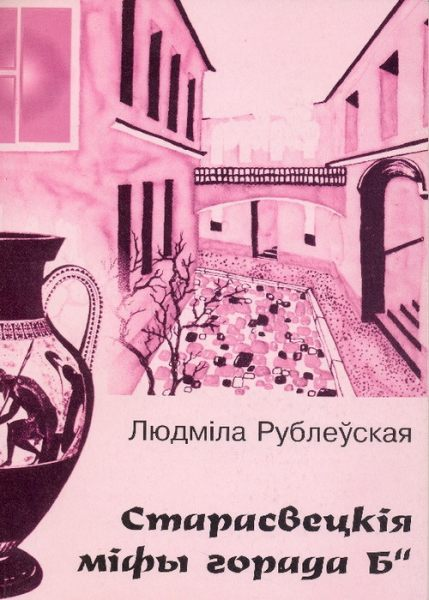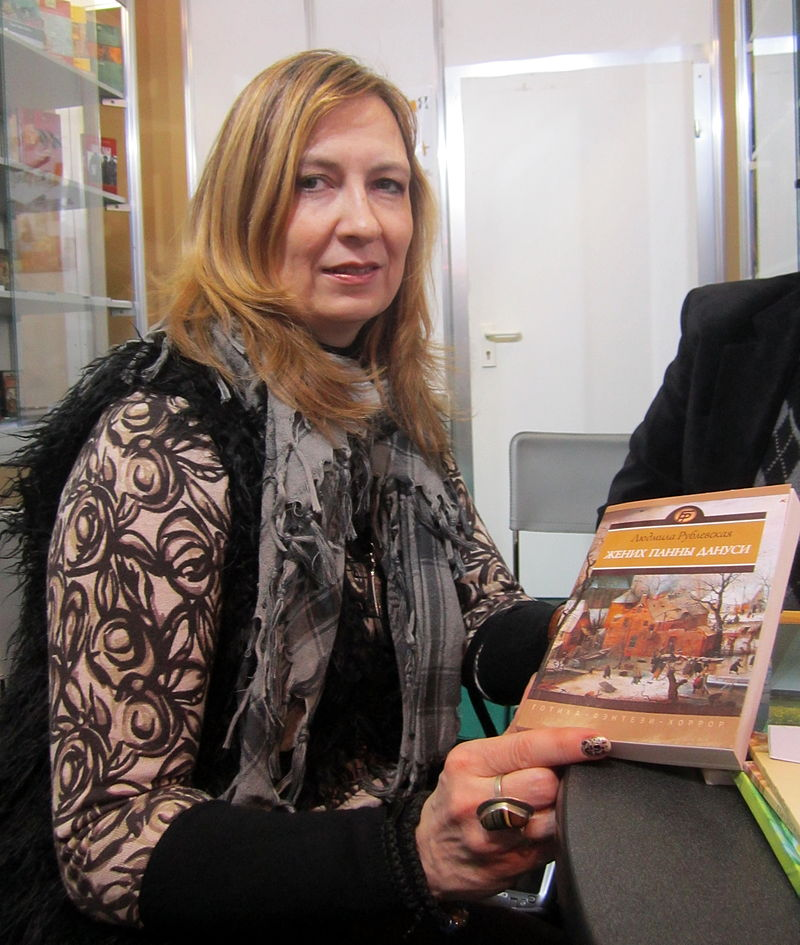Title of the work
Country of the First Edition
Country/countries of popularity
Original Language
First Edition Date
First Edition Details
Liudmila Rubleŭskaia [Людміла Рублеўская], Старасвецкія міфы горада Б* [The old world myths of the town of B* (Starasvetskiia mify horada B*)]. Maladėchna [Маладэчна]: Бібліятэчка часопіса Куфэрак Віленшчыны [Bibliatėchka chasopisa Kufėrak Vilenshchyny], 2001, 59 pp.
Available Onllne
kamunikat.org. (accessed: July 5, 2018)
Genre
Myths
Short stories
Target Audience
Young adults (children of 11–18 years old)
Cover

Retrieved from kamunikat.org. Copyright © 2001 by Rubleŭskaia L., © 2000-2022 by Kamunikat.org (accessed: December 30, 2021).
Author of the Entry:
Maria Pushkina, National Academic Janka Kupała Theatre, maryiapushkina@gmail.com
Peer-reviewer of the Entry:
Elżbieta Olechowska, University of Warsaw, elzbieta.olechowska@gmail.com
Lisa Maurice, Bar-Ilan University, lisa.maurice@biu.ac.il

Liudmila Rubleŭskaia by Gruszecki. Retrieved from Wikimedia Commons, licensed under CCBY-SA 3.0 (accessed: December 30, 2021).
Liudmila Rubleŭskaia
, b. 1965
(Author)
Liudmila Rubleŭskaia (Людміла Рублеўская) is a Belarusian poetess, writer, literary critic. She was born in Minsk. She graduated from the Architecture Department of Minsk Architecture and Construction Technical School and worked as a technical architect. In 1986-1987 she studied at the Poetry Faculty of the Literature Institute in Moscow and later on transferred to the Philological Faculty of Belarusian State University to study Belarusian philology. She has worked in various periodicals related to literature. In 2002 she started to work as an editor at the literature department of the weekly Literature and Art. Since 2003, she has been a columnist at the culture department of Belarus Today newspaper. She is best known for her historical and adventure novels, including The Heart of the Marble Angel (2001), The Ring of the Last Emperor (2002), Nights at Pliabanskia Mlyny (2007). The series Adventures of Prantsish Vyrvich (2012-2018) became very popular among readers, and one of the novels, as it was announced this year, will be filmed by Belarusfilm company.
Bio prepared by Maria Pushkina, National Academic Janka Kupała Theatre, maryiapushkina@gmail.com
Summary
The old world myths of the town of B* is a cycle of 12 stories. Each one starts with a short author's retelling of an ancient Greek myth. The title of the story includes the main characters of the corresponding ancient myths, and its plot follows the stated synopsis. The protagonists, who inhabit a generic Belarusian town at the turn of the 19th and 20th centuries, repeat the fate of ancient heroes. The similarity is vividly emphasized by the parallel details of the story:
- Artemis and Actaeon. The drunkard Charatsila looks after the bathing of the old maid Panna Kanstantsyia – an adaptation of the myth about the bathing of Artemis;
- Apollo and Marsyas. Mikalaĭ Palivanaŭ, avisiting star from St. Petersburg, competes with the tavern violinist Girsha in playing the violin – an adaptation of the myth about the musical competition between Apollo and Marsyas;
- Orpheus and Eurydice. Stas’ Harbuzok, the brewer, persuades a b-list actress Ksienia Chychalovich to return from her tour to the city of B* – an adaptation of the myth about Orpheus leading Eurydice from the Underworld;
- Pandora's box. Chemistry teacher Kaputski receives a package that everyone in the town wants to open – an adaptation of the myth about opening the jar of misfortunes;
- Narcissus and Echo. Eccentric Hanul’ka is in love withaegotistical metropolitan poet Mikalaĭ Shpadarovich – an adaptation of the myth abouta narcissistic young man and unrequited love
- Sidon and the Trojans. Alfons Burdeĭka,the spiritist and mystifier, convinces the inhabitants of the town of B* that their deceased relatives talk to them in his voice – an adaptation of the myth about the insidious capture of Troy;
- Semele and Jupiter. The half-blindAŭhinnia goes through an operation to improve her vision and now can clearly see her husband, firefighter Mikhas’ Kudyka for the first time ever – an adaptation of the myth about Jupiter’s appearance to Semele;
- The Ascension of Ganymede (Ganymede and Jupiter). Maitre d'hotel Kviatkoŭski takes Danilka, the son of an innkeeper, to Moscow and offers him work as a waiter – an adaptation of the myth aboutthe capture of Ganymede to Olympus;
- Odyssey and the sirens. Liutys’, thetelegraphist, is fascinated by the performance of the choir of the Association of Sobriety Lovers – an adaptation of the myth about the cunning escape of Odysseus from the enchanting singing of predatory sirens;
- Achilles heel. The rich man Bazyl’ Marharysh agrees to grant money to Women Protection Society – an adaptation of the myth about the murder of Achilles committed by Paris;
- Pygmalion and Galatea. Art teacher Pan Ramuald makes a portrait of Zosia and tells her about the wonders of Paris, trying to arouse her interest in art – an adaptation of the myth about the creation of Galatea;
- Heracles by Admetus – vagabond Mamon’ka is trying to get the locksmith Pamidorchyk’s wife from sectarians house - an adaptation of the myth about Heracles’ rescue of Alcestis from the Underworld.
Analysis
Liudmila Rubleŭskaia describes the conflict-freelife in the generic town of B* and pays attention to the smallest details of everyday life. This small town in the middle of nowhere can be compared to the classical descriptions of provincial towns made by Chekhov and Gogol. All the heroes of the stories represent stereotypical characters of world literature, however these images are extremely lyrical, and are made with great sympathy. Their daily routine is full of events, a living description of which is firmly fixed in city’s life in forms of gossip and rumor. Accordingly, classical mythological stories become an indivisible part of the history of the town of B*. The stories are marked with moderate burlesque and ironic rethinking of ancient myth: half-blind Semele (Aŭhinnia) is horrified when she sees the true face of Jupiter (firefighter Mikhas’ Kudyka) for the first time after her eye surgery; the tales of Pygmalion (artist Ramuald) do not encourage his model (Zosia) as much as they encourage her clumsy husband (Han’ka). Mythological ground becomes the starting point for numerous plots that thrive in the nostalgic aura of a multinational Belarusian pre-revolutionary town. This reincarnation is complemented by details that emphasize the similarity of the characters and allow us to trace the mechanisms of deconstruction of classical subjects and images. The use of ancient motifs not only romanticizes the life of the old town, but brings it closer to world traditions. Unlike most famous Belarusian mock-heroic texts, The old world myths of the town of B* don’t depict gods in a travesty of peasant images, but let urban residents adopt the behavior of mythological characters. This indicates both the continuation of traditions and the modification of this type of reception.
Addenda
The book’s title written with the use of the Belarusian Latin script, łacinka (latsinka): Starasvieckija mify horada B*.


